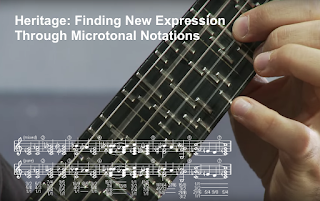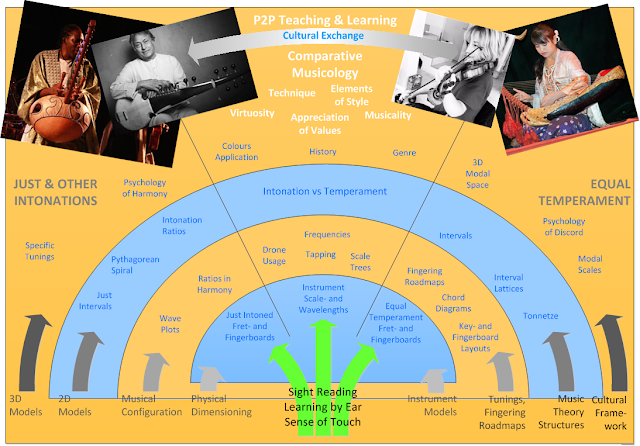The 12-tone, equal temperament music system is just one of many in use worldwide, but it’s tonal homogeneity and compatibility across octave boundaries (the ease with which a wide range of instruments can play together) and the vast and extremely accessible pool of teaching material has helped it to more or less worldwide commercial dominance.
The world's 'other' music systems -treasures in their own right- are barely acknowledged, and poorly understood.
Using data visualization techniques, could awareness of alternative, experimental and world music systems be raised?
In a post-singularity, free-time society, could we fuel a surge of interest in comparative musicology and ethnomusicology?
Some may need extended, but all the technology components lie to hand.
Big, brave, open-source, non-profit, community-provisioned, cross-cultural and crackpot crazy. → Like, share, back-link, pin, tweet and mail. Hashtags? For the crowdfunding: #VisualFutureOfMusic. For the future live platform: #WorldMusicInstrumentsAndTheory. Or just register as a potential crowdfunder..
World Music Systems
In world music, different conventions apply: other temperaments and intonations, number of notes per octave, scales, modes and tonal (read 'cultural') spaces.
Though compatibility can on several levels be severely compromised, this is a vast and (for ‘western’ ears) often untapped field of exploration.
We lack on the one hand the cultural experience and exposure to truly appreciate the qualities of much of this music, and on the other, the comparative musicology tools to relate them back to what we do understand.
With our plans for a world music visualization aggregator platform, this is about to change.
World Music Diversity
Beyond already diverse world music instrument base configurations, musical diversity really takes off - in the form of tunings and musical scales. There are many thousands of each.
On a lute-like instrument, for example, tunings applicable to a low-order number of courses find reapplication each time a string is added to the configuration. In this sense we can immediately begin to think of hierarchy and reuse.
Complicating this is that what may be (say) a 'B' tone in one culture may have a different name, pitch and frequency in another culture. In this sense, we need to abstract down to core, measurable physical qualities.
Much the same applies to musical scales. To get an idea of the scope, we might try to gauge how many musical scales there are there in use worldwide.
Only 1% of musical terrain is represented by the 1490 scales known alone to 'western' or classical music. Yet this is the fruit of just one of perhaps hundreds of musical systems in use worldwide.
Brave souls on Quora looked at this ballpark in a little more detail, but could still only give vague guesstimates. The fact is, we simply don't know.
Indigenous Turkish, Arabic, Persian and Indian music, like many other world music systems, are microtonal in nature. While often sharing the concept of scales and modes, their intervals and note frequencies and the laws determining them are a world to themselves.
Turkey has more than 100 makams or maqams (microtonal scales) based on a system of just intonation.
The Persian Dastgah system has some overlap with Maqam (namely Rast) but otherwise on the whole the tonalities used differ.
Arabic Makams or Maqams again share the affinity with Rast, but are anchored in a 24-tone (ie microtonal) equal temperament system.
The Indian Raga is shared by both North Indian (Hindustani) and South Indian (Carnatic) music traditions, and based on an octave with 22 srutis or microintervals of musical tones or 1200 cents.
Musical Innovation
Experimental music stretches such envelopes yet further. Musical interfaces of the future will allow much greater (possibly even shape-changing) configuration flexibility, enhanced interfacing sensitivity, tonal variety and new modes of interaction, opening up a galaxy of new possibilities.
With growing experience, the tonal system on which a piece of music is based may, for dramatic effect, even be allowed to change with time.
Music is undergoing an explosion of experiment and development - entirely paralleling that of science and technology in it’s depth and reach.
It's helpful in this context to see the various instrument configurations and underlying music systems as respectively nodes and vectors in a musical continuum.
With it’s roots in mathematics -which lends itself to algorithm- artificial intelligence and machine learning can be expected to bring both new freedoms and new challenges. In modelling it's parts, I hope we become more familiar with the whole.
Comparative Musicology And Ethnomusicology
In-browser, score-driven animations open up fascinating possibilities for musical learning, immersion, exchange - and comparison.
Notation is simply a base for tonal mappings, one notation source sometimes relevant to several tuning systems. That is to say that (for example) instruments tuned to a system other than the western equal temperament can in some cases still be played while referring to a standard western score.
Concepts close to this, such as so-called transnotation, though long debated by ethnomusicologists, have yet to find their way into musician's toolsets.
Change is, however, imminent. Tonal systems -whether on an instrument model or on the basis of a theory tool (an abstraction)- can increasingly be visually compared. This draws us into the world of comparative, or 'what if?' musicology, but also ethnomusicology.
There are often many ways of visualizing these tonal differences: waveforms, relative note positions on a linear or logarithmic scale, chromatic circle or circle of 5ths, frequency scatterplots, coordinate systems, chromatic helix, and so on. The tools have to date been short of one critical component: a system to allow their automatic association with scores, and for them to be exchanged at will. The concept (and demo) exist: the idea simply needs financed.
Indeed, with many graphical theory representations available, we have the opportunity to compare theory tools, side-by-side on the screen.
Music theory is only one side of the story: we have the possibility of comparison not just in an abstract theoretical sense, but in the sense of practical impact on instrumental use.
At a simple level we may wish to compare the impact of various equal temperament guitar tunings on fingering (and hence, ultimately, tension, timbre and dynamics).
We can also answer tricky musical questions - visually. Could a just-intoned turkish bağlama or saz can be played alongside a 12-tone equal-temperament instrument, such as clarinet or african kora? Just how far apart, tonally, are the notes? What happens if we move to a higher octave?
Going further afield, how about comparison of the note namings, frequencies and intervals of the arabic ney with that of the traditional chinese Dizi (transverse flute) or it's modern counterpart, the Xindi?
This would also helpful to an established player on one instrument curious to know which other instruments (and especially timbres) would be available at little or no learning overhead. In this way, a search based on the violin's musical configuration characteristics would reveal that banjo, bouzouki and mandolin are very similar, all sharing the same layout and pitch classes, if not necessarily the same scale length or octave range.
Answers to questions like these could be approached visually in a multitude of ways.
At the End of the Day
The possibilities opened by music visualization go way beyond instruments and theory tools, covering everything from (for example) graphical overviews of musical compatibility, evolutionary tracking diagrams, cross-cultural influences, to musical development under migration. The only limitations are imagination and time, both of which will be in surfeit in a free-time world.
Moreover, with time, data collection relating to these developments could theoretically be automated, leading to running updates to such animations.
If the fuel on this journey is data, then the vehicle is a world music aggregator platform. Well-founded, I suspect this initiative has a vibrant future. Somewhat surprisingly, this has never before been attempted.
It's clear there are mobile device bottlenecks (speed), security issues (SVG is scriptable), and the end product (and hence value) is relatively easy hijacked - even if just as captured video. Nevertheless, I am still at a loss as to why there has been no movement. This will now change.
Keywords
online music learning,
online music lessons
distance music learning,
distance music lessons
remote music lessons,
remote music learning
p2p music lessons,
p2p music learning
music visualisation
music visualization
musical instrument models
interactive music instrument models
music theory tools
musical theory
p2p music interworking
p2p musical interworking
comparative musicology
ethnomusicology
world music
international music
folk music
traditional music
P2P musical interworking,
Peer-to-peer musical interworking
WebGL, Web3D,
WebVR, WebAR
Virtual Reality,
Augmented or Mixed Reality
Artificial Intelligence,
Machine Learning
Scalar Vector Graphics,
SVG
3D Cascading Style Sheets,
CSS3D
X3Dom,
XML3D
ANY: Music System ◦ Score ◦ Voice ◦ Instrument Or Theory Tool Config ◦
World Music's DIVERSITY and Data Visualisation's EXPRESSIVE POWER collide. A galaxy of INTERACTIVE, SCORE-DRIVEN instrument model and theory tool animations is born.
Entirely Graphical Toolset Supporting World Music Teaching & Learning Via Video Chat ◦ Paradigm Change ◦ Music Visualization Greenfield ◦ Crowd Funding In Ramp-Up ◦ Please Share
Featured Post
All Posts (*** = Recap)
- User Environment - Preferences and Population
- Comparative Musicology & Ethnomusicology
- Music Visualisation - a Roadmap to Virtuosity ***
- A Musical Instrument Web Repository
- Toolset Supported Learning Via Video Chat
- Key Platform Features ***
- Platform Aspirations
- Aggregator Platform vs Soundslice
- Music, Machine Learning & Artificial Intelligence
- World Music Visualisations And The 3D Web
- Cultivating Theory Tool Diversity
- Cultivating Instrumental Diversity
- Cultivating Notation Diversity
- Cultivating Music System Diversity
- One URL To Animate Them All And In The Browser Bind Them ***
- Music Visualisation: Platform Overview
- Music Visualisation: Challenges
- Music Visualisation: The Key To Structure
- Music Visualisation: Motivation ***
- Music Visualisation: Key Concepts ***
- Music Visualisation: Social Value
- Music Visualisation: Prototype
- Music Visualisation: Catalysts
- Music Visualisation: Platform Principles
- Music Visualisation: Here Be Dragons
- Music Visualisation: Potential
- Music Visualisation: The Experimental Edge
- Music Visualisation: Business Models
- Music Visualisation: Technical Details
- Music Visualisation: (Anti-)Social Environment
- Music Visualisation: Arts, Crafts, Heritage
- Music Visualisation: Politics
- Music Visualisation: Benefits ***
- PROJECT SEEKS SPONSORS
- Consistent Colour Propagation
- Orientation: Genre-Specific Workflows
- P2P Teacher-Student Controls
- Musical Modelling
- Social Media Integration
- Platform Provisioning In Overview
- Generic to Specific Modelling: A Closer Look
- Notation, Standardisation and Web
- Communication: Emotional vs Technical
- Musical Storytelling
- Product-Market Fit
- Monthly Challenge
- World Music Visualisations and Virtual Reality
- World Music Visualisations: Paradigm Change?
- How Does It All Work Together?
- Off-the-Shelf Animations: Musical Uses
- MVC vs Data Driven
- A Reusable Visualisation Framework
- What IS Music Visualisation?
- Questions Music Visualisations Might Answer
- Google Group for World Music Visualisation
- Instrument Visualization: Fingering Controls
- Static, Active, Interactive, Timeline-Interactive
- Visualising Instrument Evolution
- Unique Social Value (USV)
- Instrument Modelling: Lute Family
- Person-to-Person ('P2P') Music Teaching
- Alternative Music Visualizer Scenarios
- Music Visualisation: Why a platform, not just an app?
- Music, Dance and Identity: Empowerment vs Exploitation
- Why No Classification System For Music Theory?
- Musical Heritage, Copyright and Culture
- Visualisation Aggregator Platform - Musical Immersion
- Instrument Models - Complete Configuration Freedom
- Diversity is Health, Contentment is Wealth
- Politics & Provisioning Mechanisms of World Music Learning
- Technology, Tribes, Future and Fallout
- Rule-Based vs Data-Driven Notation
© Copyright 2015 The Visual Future of Music. Designed by Bloggertheme9 | Distributed By Gooyaabi Templates. Powered by Blogger.







1 comments:
Write commentsWorld Music Systems, Comparative Musicology And Ethnomusicology - The Visual Future Of Music >>>>> Download Now
Reply>>>>> Download Full
World Music Systems, Comparative Musicology And Ethnomusicology - The Visual Future Of Music >>>>> Download LINK
>>>>> Download Now
World Music Systems, Comparative Musicology And Ethnomusicology - The Visual Future Of Music >>>>> Download Full
>>>>> Download LINK 7H
Comments, questions and (especially) critique welcome.